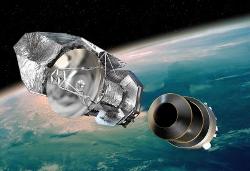Dec 31 2009
An instrument package developed in part by the University of Colorado at Boulder for the $2.2 billion orbiting Herschel Space Observatory launched in May by the European Space Agency has provided one of the most detailed views yet of space up to 12 billion years back in time.
 This is the Herschel Space Observatory
This is the Herschel Space Observatory
The December images have revealed thousands of newly discovered galaxies in their early stages of formation, said CU-Boulder Associate Professor Jason Glenn, a co-investigator on the Spectral and Photometric Imaging Receiver, or SPIRE instrument, riding aboard Herschel. The new images are being analyzed as part of the Herschel Multi-tiered Extragalactic Survey, or HerMES, which involves more than 100 astronomers from six countries.
Equipped with three cameras including SPIRE, the Herschel Space Observatory was launched in May 2009 from Europe's Spaceport in French Guiana. The spacecraft -- about one and one-half times the diameter of the Hubble Space Telescope -- is orbiting nearly 1 million miles from Earth.
Herschel is the first space observatory to make high-resolution images at submillimeter wavelengths, which are longer than visible and infrared light waves and shorter than radio waves. SPIRE was designed to look for emissions from clouds and dust linked to star-forming regions in the Milky Way and beyond, said Glenn. The most recent observations were made in the constellation Ursa Major, which includes the Big Dipper.
CU-Boulder is receiving roughly $2 million from NASA for the combined support of SPIRE instrument development and science data analysis during the lifetime of the orbiting telescope, said Glenn, an associate professor in CU-Boulder's astrophysical and planetary sciences department. NASA's Jet Propulsion Laboratory and CU-Boulder built essential instrumentation for the telescope used to make the most recent observations, said Glenn, also a member of CU-Boulder's Center for Astrophysics and Space Astronomy.
"The submillimeter sky is absolutely paved with galaxies," Glenn said. The newest images are "amazingly clear and deep," which enables astronomers to detect distant galaxies they would have no chance of discovering with current ground-based telescopes, he said. Since the light being observed with Herschel left the galaxies billions of years ago on its journey toward our solar system, the images are helping to reveal early star formation activity as well as the growth of supermassive black holes in galaxies.
The Herschel team expects to discover hundreds of thousands of new galaxies at very early stages of their formations -- some more than 10 billion years old, he said. A single image from Herschel released in December revealed 10 times as many galaxies as have been seen before by all of the world's telescopes observing the skies in submillimeter wavelengths, said Glenn.
A major goal of the Herschel mission is to discover how early galaxies formed and evolved to give rise to present-day galaxies like our own, he said. Distant galaxies imaged by Herschel are so far away astronomers actually are looking at conditions as early as just over a billion or so years after the Big Bang some 13 billion years ago. The SPIRE camera allows Herschel to detect radiation from very cold and distant objects, such as young stars and evolving galaxies.
The SPIRE team is studying the physical and chemical processes that take place in the distant interstellar medium to learn more about how stars are formed from molecular clouds, Glenn said. The submillimeter colors of the galaxies in the new images reveal information about their temperatures and distances -- bluer galaxies are relatively hotter and nearer, while the redder galaxies are cooler and farther away, he said.
Glenn said CU-Boulder also is partnering on a ground-based telescope project known as the Cornell Caltech Atacama Telescope, or CCAT -- slated for completion in 2013 in the Atacama desert of Chile at 18,400 feet in altitude -- which will be able to zoom in on regions imaged by Herschel and isolate individual galaxies with 10 times greater detail. CASA is working to raise roughly $5 million in private capital toward the cost of CCAT, Glenn said.
SPIRE is one of three instruments on Herschel and has both a camera and a spectrometer. Led by the United Kingdom, SPIRE also includes participation by a number of American, Canadian and Chinese institutions. Glenn's group is particularly interested in characterizing the faintest, most distant galaxies, "which will push the orbiting observatory to its limits of sensitivity," he said.
"Herschel is providing a whole new window on the universe," said Glenn. "This project provides a fantastic opportunity for top scientists from around the world to work together to understand how stars and galaxies form and evolve."